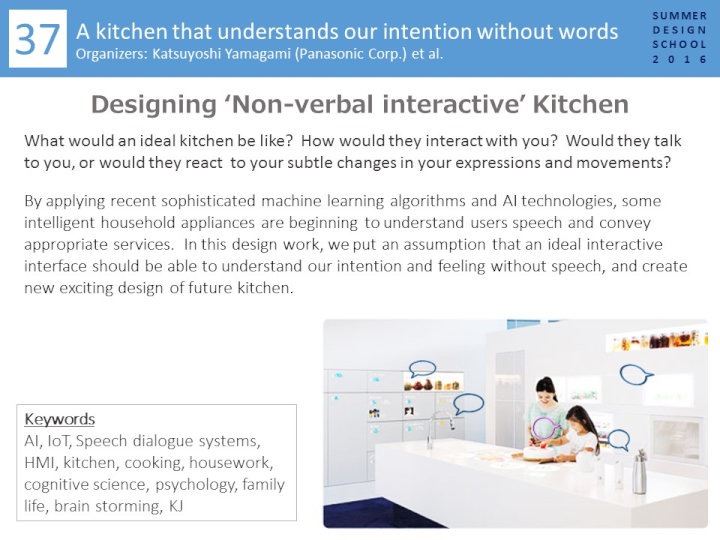Let’s be free from implicit preconceptions and create a new exciting design of future kitchen that understands our feeling.
| Name | Organization | Specialty |
|---|---|---|
| Katsuyoshi
Yamagami |
Interactive AI research group, Advanced Research Division, Panasonic CO. | Man-MachineDialog,
Natural Language Processing |
| Mitsuhiro Aso | Corporate Engineering Division, Appliances Company, Panasonic CO. | Could-based Service Design |
| Zarina Rafii | Corporate Engineering Division, Appliances Company, Panasonic CO | Image Processing |
| Shohei Nobuhara | Graduate School of Informatics, Kyoto University | Image Processing |
| Daisuke Kawahara | Graduate School of Informatics, Kyoto University | Natural Language Processing |
Recently we see some home appliances in our daily life that are becoming more intelligent thanks to sophisticated machine learning algorithms and Artificial Intelligence. Apple’s Siri, Amazon’s Echo (Alexa), or Microsoft’s Cortana are examples of such
appliances. They can understand user’s speech and provide user-intended information or functions. Such interactive devices play a role like a ‘order-taker’ in modern times.
However, it is sometimes bothersome to interact with those devices by speech, as users need to express their intention by selecting exact expression in natural language.
In our design work, we put an assumption that an ideal interactive interface should be able to understand user’s intention from user’s situation without speech, and discuss how such interface would be realized.
Let’s join us and design ‘Non-verval Interactive Kitchen’ of a future life scene.
- Skills for constructing concepts or visions through discussion
- Skills for explaining values of concepts logically
- Skills for defining ctitical challenges or problems to realize concepts
- Skills for drawing reasonable approaches to solve problems
Brain Storming, KJ-method
[Design methods]- Understanding a problem
- Gathering Information
- Thinking by sketching and choose one
- Production
- Refinement
- Panasonic Center Osaka (GRAND FRONT OSAKA, Umeda, Osaka)
- Wonder Lab Osaka (Panasonic CO., Kadoma, Osaka)
- Ice break & self introduction
- Declalation of a problem & sharing output image of the design work (by leader)
- Getting awareness through experience of kitchen work
- Collecton of problems (Brainstorming)
- Summarization of problems (KJ-method)
- Making an ideal vision (Brainstorming & KJ-method)
- Making ideas to realize a vision (Brainstorming)
- Making ideas to realize a vision (Brainstorming)
- Summarization of ideas(KJ-method)
- Integration of ideas (toward total design)
- Prepare for presentation (KRP)
- Present workshop results (KRP)
